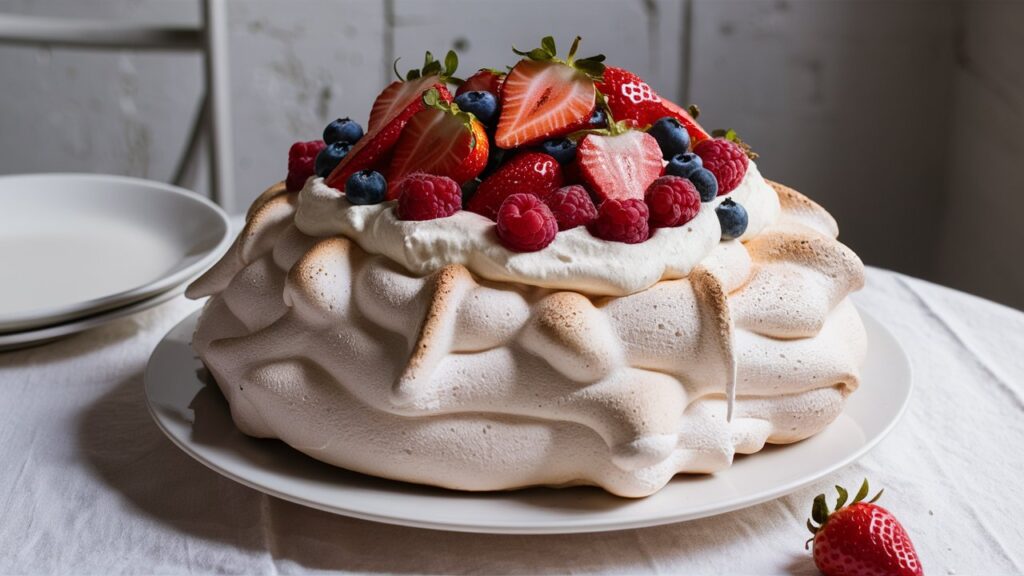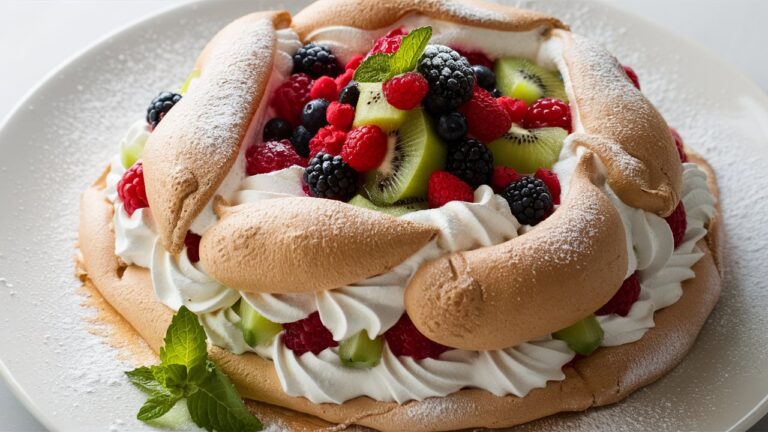Introduction: A Dessert Steeped in History and Grace
Named after the legendary Russian ballerina Anna Pavlova following her tours of Australia and New Zealand in the 1920s, pavlova embodies ethereal lightness and elegance. This iconic dessert—a crisp meringue shell encasing a marshmallow-soft interior, crowned with whipped cream and seasonal fruit—sparks friendly trans-Tasman rivalry over its true origins. Culinary anthropologist Helen Leach traces early New Zealand recipes to 1929, while Australians cite Bert Sachse’s 1935 creation at Perth’s Esplanade Hotel 27. Despite this debate, pavlova remains a cherished national treasure in both countries, especially during summer celebrations like Christmas 57. British cooking authority Delia Smith demystifies pavlova-making with her rigorously tested, no-fuss approach, emphasizing technique over extraneous ingredients. Her recipe, refined over decades, proves that perfection hinges on precision rather than complexity 13.
Delia’s Culinary Philosophy: Simplicity and Precision
Delia Smith revolutionized home cooking by emphasizing reliability and clarity. Her pavlova recipe, adapted from Delia’s Complete Cookery Course, omits traditional cornflour and vinegar—ingredients many believe essential for the marshmallow center. Through side-by-side testing, she confirmed they offer negligible textural benefits 8. Instead, Delia prioritizes:
- Ingredient Ratios: 175g caster sugar to 3 large egg whites (approximately 120g whites), ensuring balanced sweetness and structure.
- Whisking Technique: Egg whites whipped to stiff peaks before sugar incorporation, creating a stable meringue 13.
- Baking Methodology: Initial high heat (150°C) followed by immediate reduction to 140°C (Gas Mark 1) for 1 hour, then slow cooling in the switched-off oven to prevent cracking 14.
This minimalist philosophy empowers home cooks, transforming pavlova from a temperamental showstopper into an achievable classic.
Crafting Delia’s Pavlova: Step-by-Step Mastery
The Meringue Base: Science Meets Art
Success begins with meticulous preparation:
- Egg Whites: Use room-temperature, spotlessly separated whites (no yolk traces). A copper, glass, or stainless steel bowl prevents grease contamination.
- Whisking: Beat whites to stiff peaks—firm enough to hold their shape when the bowl is inverted. Delia’s online video clarifies this critical stage, distinguishing it from her earlier soft-peak guidance in 1977 publications 3.
- Sugar Integration: Add sugar 1 tablespoon at a time, whisking thoroughly after each addition. The meringue should become thick, glossy, and form defined peaks.
- Shaping: Spoon 1/3 of the meringue onto parchment-lined baking trays, forming a 20cm circle. Create decorative swirls with a skewer for visual flair 14.
- Baking & Cooling: Bake at 140°C for 1 hour. Turn off the oven, leaving the pavlova inside until completely cold (minimum 4–6 hours, ideally overnight). This prevents collapse and ensures the signature crisp-yet-yielding texture 14.
Toppings: Elegance Through Contrast
Delia’s strawberry-vanilla combination highlights her belief in balancing sweetness with acidity:

- Cream Filling: Whisk 300ml double cream with 2 tbsp icing sugar and 1 tsp vanilla extract until softly pillowy (avoid over-whipping to butteriness!).
- Fruit Prep: Purée 1/3 of strawberries with sugar, then sieve for a smooth coulis. Halve remaining berries for topping.
- Assembly: Fill the meringue’s center with cream, arrange strawberries artistically, dust with icing sugar, and drizzle coulis just before serving. Flexibility is key—raspberries, passionfruit, or seasonal peaches work beautifully 1712.
Table: Delia’s Method vs. Common Pavlova Variations
| Component | Delia’s Approach | Common Alternatives |
| Stabilizers | None | Vinegar + cornflour 8 |
| Sugar Ratio | 175g per 3 egg whites | 150–330g per 3–4 whites 8 |
| Baking Temp | 140°C after initial high heat | 120–150°C 2 |
| Filling | Vanilla cream + sharp fruit | Mascarpone/yogurt blends 89 |
Troubleshooting Common Pavlova Challenges
Even experts encounter issues. Delia’s method mitigates pitfalls:
- Weeping or Collapse: Caused by under-whisked egg whites or residual grease. Ensure bowls are spotless and peaks truly stiff 311.
- Cracking: Rapid temperature changes are the culprit. Cool gradually in the switched-off oven 1.
- Sticky Base: Overbaking or humidity exposure. Store undecorated meringues airtight for up to 3 days; add toppings only before serving 38.
- Soggy Bottom: Shield with melted chocolate before adding cream, or invert the base so the marshmallow layer melds with filling 8.
Table: Pavlova Troubleshooting Guide
| Issue | Cause | Solution |
| Weeping/Sweating | Under-whisked egg whites | Whisk to stiff peaks; clean bowl |
| Cracks | Rapid cooling | Cool in turned-off oven overnight |
| Chewy Texture | Overbaking | Limit bake time to 1 hour |
| Sticky Crust | Humidity exposure | Store airtight in cool place |
Beyond Strawberries: Creative Adaptations
Delia encourages innovation:
- Tropical: Mango, passionfruit, and toasted coconut.
- Winter Citrus: Blood oranges, pomegranate, and cardamom cream.
- Decadent: Dark chocolate shavings and espresso-spiked cream 1812.
Passionfruit’s tartness is a classic Antipodean choice, while Britain favors strawberries. Kiwifruit remains a New Zealand staple 27.
Cultural Significance: More Than a Dessert
Pavlova’s legacy transcends recipes. In Australia and New Zealand, it symbolizes summer festivities and national pride. “Pavzilla,” a 45-meter pavlova created for Wellington’s Te Papa Museum, and Hawke Bay’s 64-meter “Pavkong” underscore its cultural resonance 2. Delia’s version democratizes this icon, proving that flawless execution relies on understanding fundamentals—not rigid formulas.
Conclusion: The Timeless Appeal of Mastery
Delia Smith’s pavlova epitomizes her culinary ethos: precision, simplicity, and respect for ingredients. By distilling the method to its essentials—perfectly whipped meringue, patient baking, and balanced toppings—she empowers cooks to achieve dessert excellence. Whether adorned with summer berries or winter citrus, this pavlova remains a testament to the beauty of technique over trend.
Frequently Asked Questions (FAQs)
1. Can I make pavlova ahead of time?
Yes! Bake the meringue base 1–2 days in advance. Store undecorated in an airtight container at room temperature. Add cream and fruit only 1–2 hours before serving to prevent sogginess. Fully assembled pavlovas can be refrigerated briefly but will lose crispness 34.
2. Why does Delia omit cornflour and vinegar?
Through comparative testing, Delia found these stabilizers offered minimal textural improvement. Her method relies on stiffly whipped egg whites and gradual sugar incorporation for structure 18.
3. Can I freeze pavlova?
Freeze unadorned meringue bases only. Open-freeze until solid, then wrap tightly in cling film. Thaw at room temperature for 2 hours before decorating 3.
4. What fruits work best?
Opt for tart fruits to counterbalance sweetness: strawberries, raspberries, passionfruit, or peaches. In winter, citrus or stewed rhubarb are excellent 18.
5. How do I prevent a chewy or sticky meringue?
Ensure thorough sugar dissolution during whisking, and avoid overbaking. Humidity accelerates stickiness; store in a cool, dry place 311.
6. Is a stand mixer essential?
No. Delia notes handheld electric mixers effectively prevent unwhisked whites pooling in stand mixer bowls 4.
